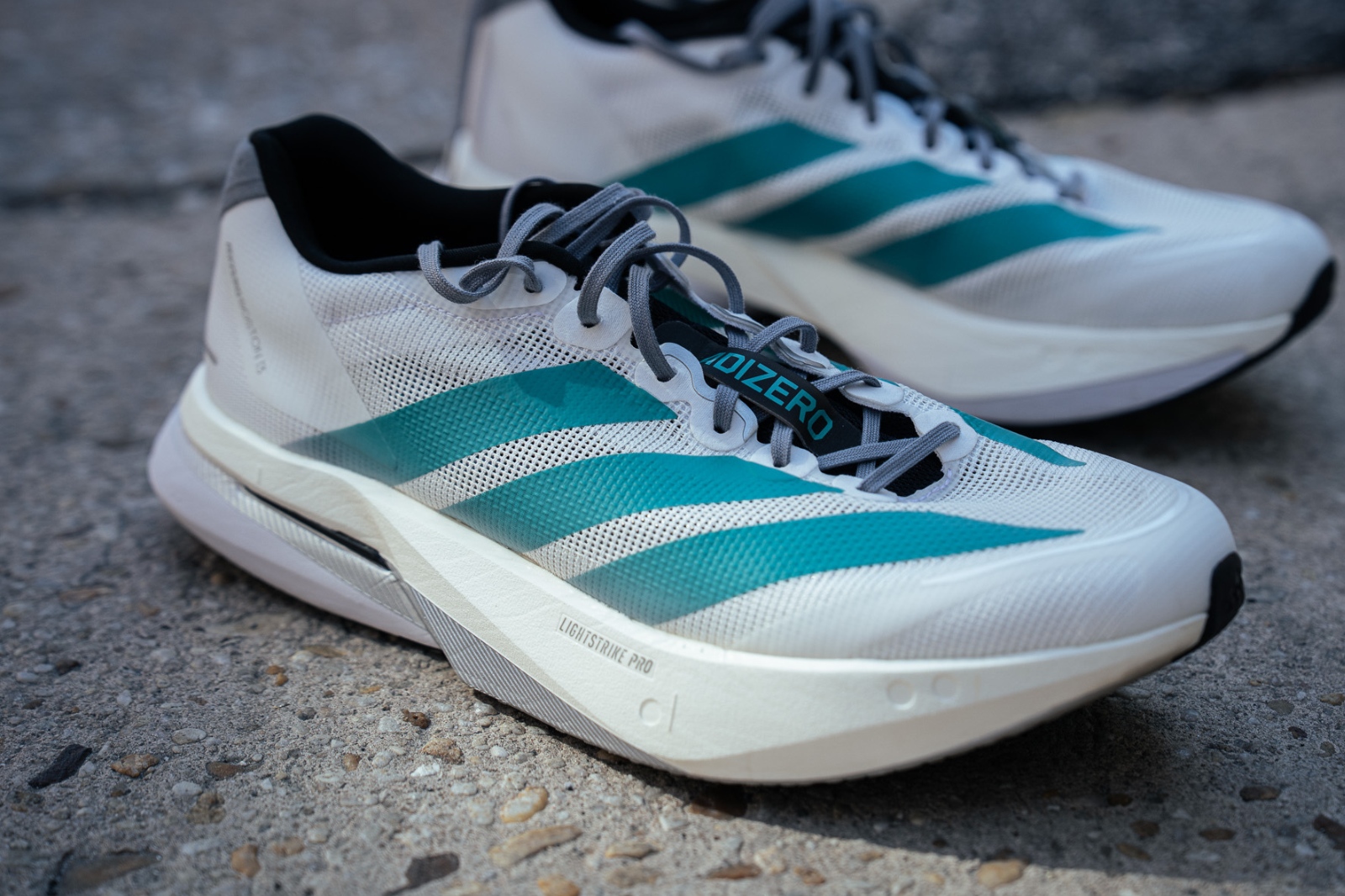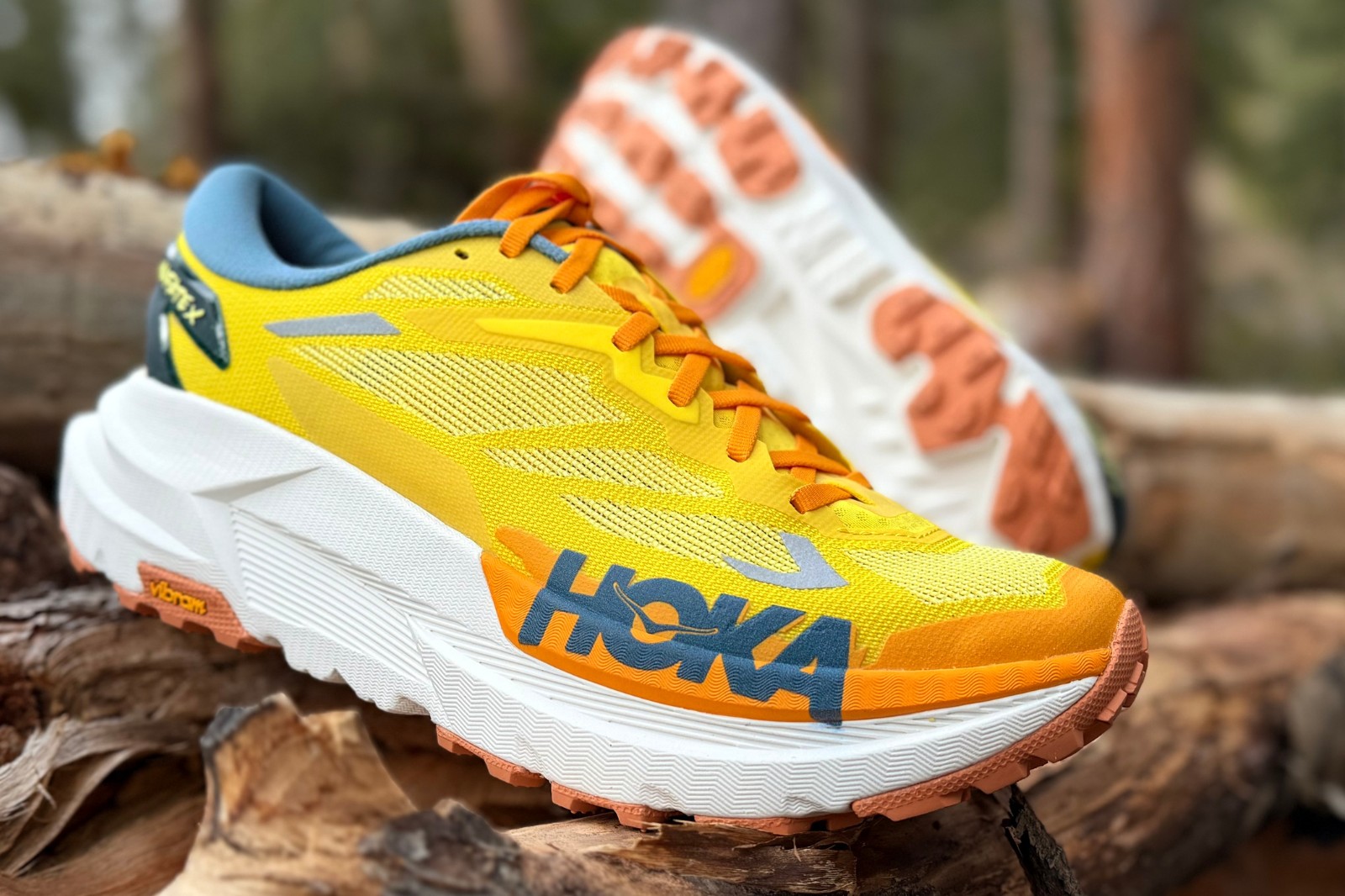
We independently review everything we recommend. When you buy through our links, we may earn a commission.
12.1 oz. (343 g) for a US M10 / 10.3 oz. (292 g) for a US W8
49 mm in heel, 41 mm in forefoot (8 mm drop)
Long-distance efforts on smoother terrain
PEBA-cored midsole, Vibram Megagrip outsole, Carbon fiber plate, EVA carrier foam, Woven textile upper
Available now for $225















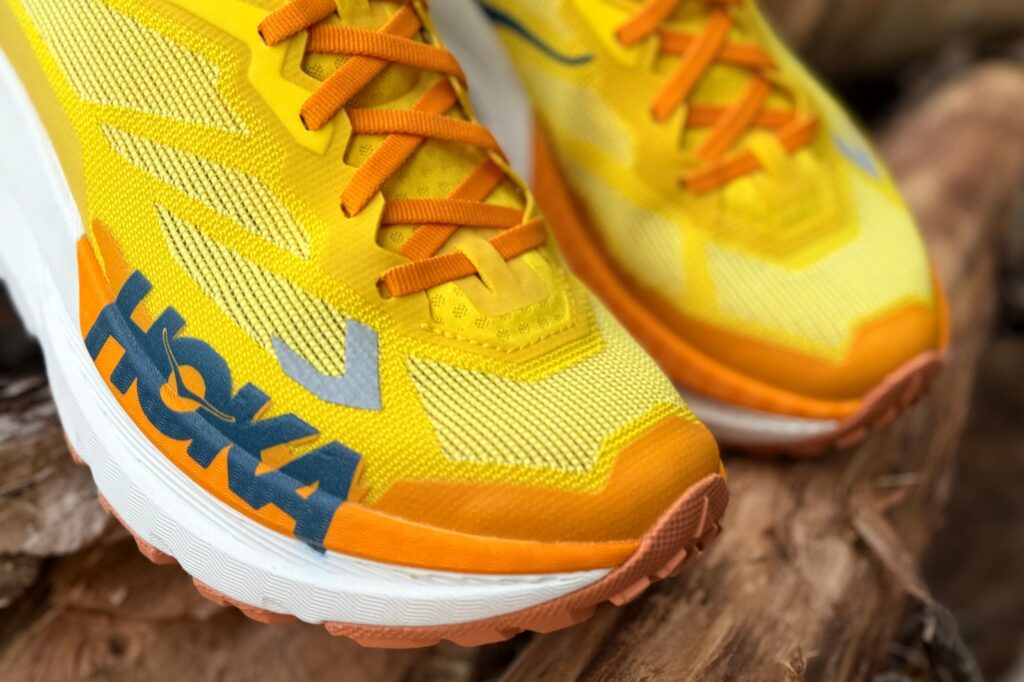
TAYLOR: In a world (insert dramatic timpani)… of monsters… (continue with the timpani) Is it true that the grandest will rule them all? A new behemoth has risen from the depths. It’s the Hoka Mafate X!
I can’t get away from my childhood love of dinosaurs and monsterverse characters whenever I review these max-stack shoes. There’s a parallel that over the years our imagination has escorted these creatures to unreal dimensions in the hopes that bigger is better. At one point, in the not-so-distant past, a shoe that passed the 30 mm stack mark was considered wildly cushioned. Then, that mark became 34 mm, 37 mm, 40 mm…
Just as soon as I thought we were starting the pendulum swing again, the Hoka Mafate X did the old “hold my beer” thing and blasted far beyond anything we’ve seen so far. Although I do think it’s fitting for Hoka to be the company to claim the highest stack shoe, but jeesh! Have we gone too far, Cotton?
Thankfully, we live in a modern age where designers have thousands of materials at their fingertips and tech that could darn near take us to the moon. So, the Mafate X isn’t just debuting with a sky-high slab of foam. There’s layer after layer of intentional ingredients that seek to put runner comfort first.
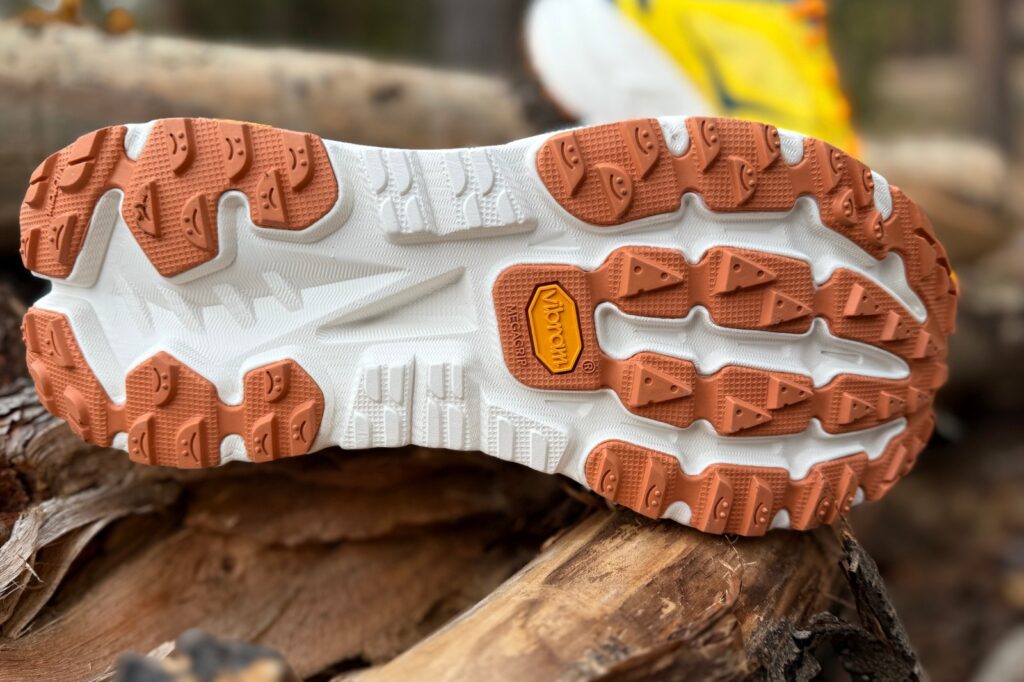
ALLISON: Hoka Carbon X, Rocket X, Bondi X, Tecton X… it’s safe to say X marks the spot for HOKA. And next up on the treasure map? The Mafate X. (Looks like they skipped over the Speedgoat X, but maybe it’s still hiding in the vault.)
Going in, I had no idea what to expect. The Mafate line has traditionally sat lower in stack height than the Speedgoat, but Hoka clearly said, “Let’s go thicc,” and delivered — no surprise from the brand behind the Skyward X.
So, how does all that translate to the trail — or even a rail-to-trail? Stick around to find out.
MICHAEL: Just the other day, my wife and I were listening to a podcast about whales. You know, as one does… whales are awesome. Anyway, one of the fun facts they mentioned in the introduction was that Orca whales actually follow trends. Like, fashion trends. In 1987, some scientists noticed Orcas were killing salmon and ‘wearing’ them on their heads. Why did they do this? Who’s to say, but like all fads, the salmon drip popularity waned, and after about a year, no whales were seen sporting them.
But just last year, scientists began noticing the fish hats were back in style, like an old Taco Bell dollar menu item from the 90s roaring back to life. Before you knew it, ‘vintage, concert-worn’ salmon hats from the 80s were being dug up from parents’ basements and are currently being auctioned off on eBay for thousands of dollars as we speak. I even heard they are going to sell some of the rights to Urban Outfitters. Soon, pre-faded, acid-washed salmon hats are going to hit the shelves right alongside Nirvana (you know, the T-shirt brand) and that other clothing designer who came up with the cool triangle rainbow logo. (Despite my confusing sarcasm, this is an actual podcast episode on Radiolab. Enjoy!)
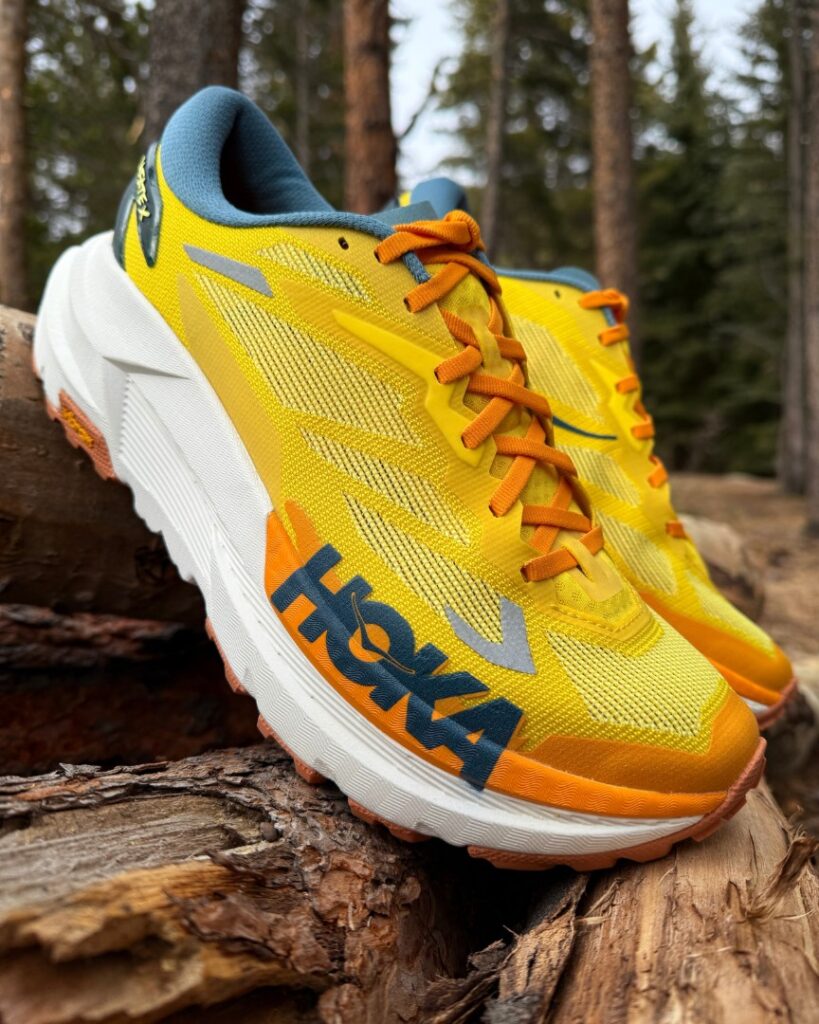
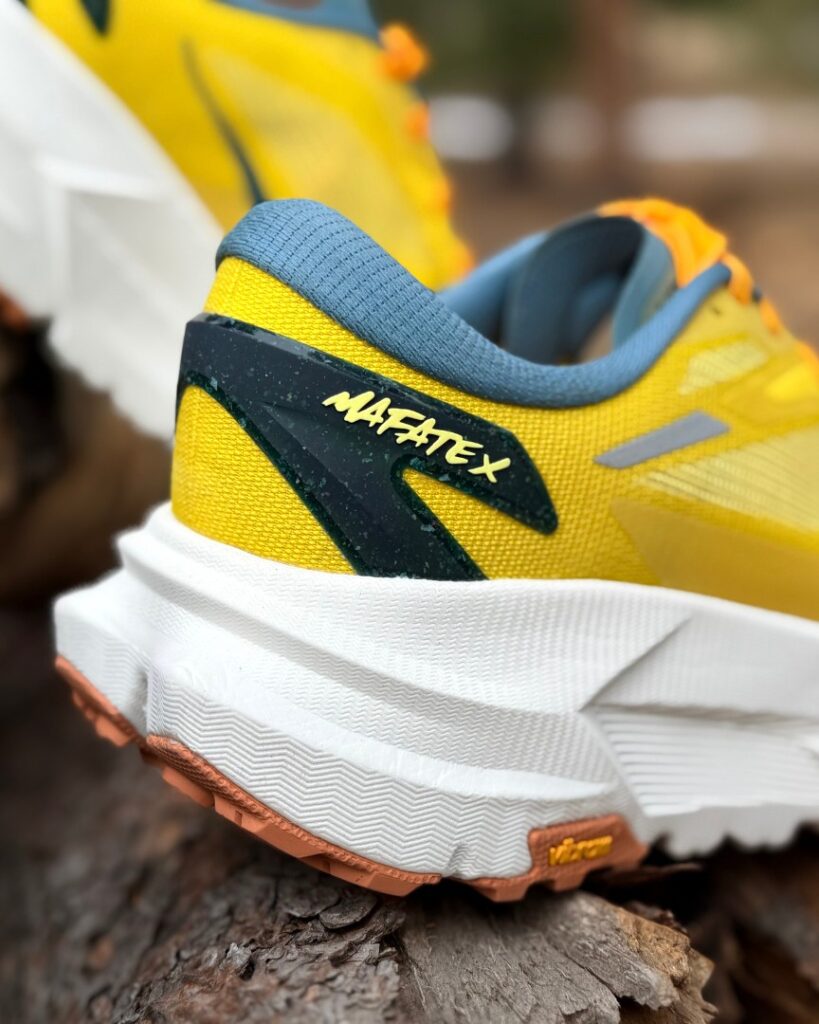
So, where am I going with this? Well, it’s safe to say that just like Orcas, our funky trends have a way of coming and going here in the world of trail running. But in these ever-shifting sands of fashion and technology and nutrition, there are two things I can think of that never go out of style – comfort and carbs. (Well, that is except for when we all thought harsh, minimalist footwear was a good idea, but we don’t like to talk about that here). The point being, no matter what other technologies are out there, a shoe that’s comfortable to run in is going to go the distance, both literally and figuratively.
Unfortunately, physics has presented some barriers to making a super-stacked, super-cushioned trail shoe. We’ll call these the three horsemen of maximalist footwear: weight, sluggishness, and stability. Over the years, the warriors of the shoe world have forged some pretty decent weapons to fight against them. In the battle against instability, the Brooks Caldera and Hoka Stinson feature a “bathtub” construction and a massive footprint. In the fight against sluggishness, the piercing arrows of supercritical foams and carbon plates were unleashed in the Speedland GS:PDX. So, naturally, it was time for Hoka to get in on the party and create a wildly comfortable, yet versatile ultra-distance racing shoe to conquer all three horsemen once and for all. Enter the Mafate X.
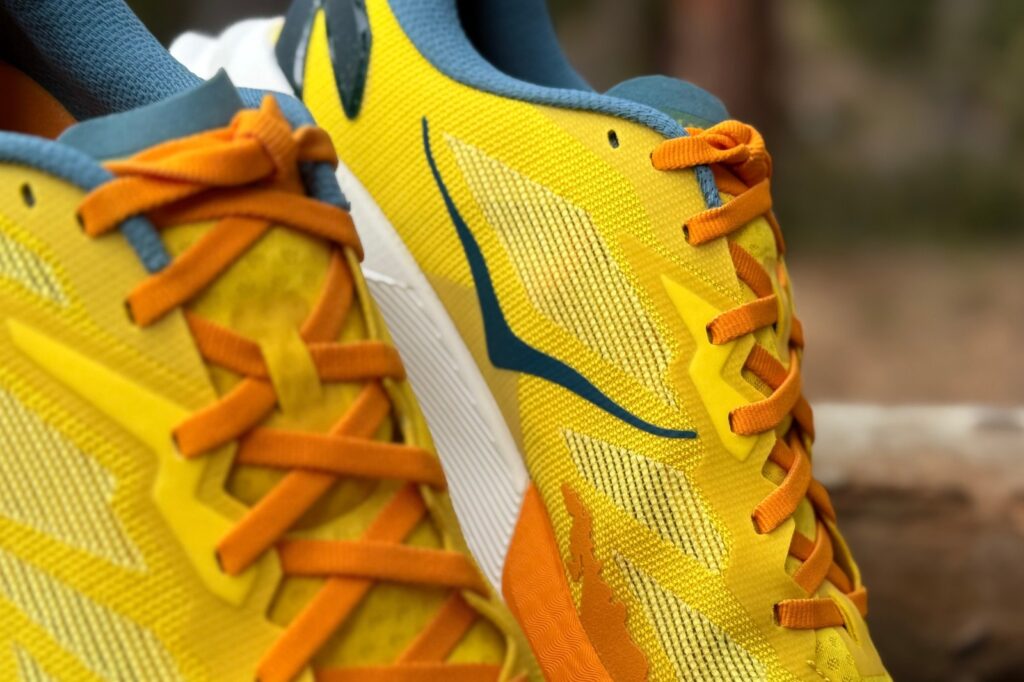
TAYLOR: When I say comfort comes first, I mean it’s the utmost priority. Comfort is performance with the Hoka Mafate X. Every layer and seam (or lack thereof) is thought of to keep the runner’s feet in nirvana.
Often, with such high stack shoes, a sense of disequilibrium can happen from top to bottom because the upper construction is too light to support the rest of the shoe. That is not the case with the Hoka Mafate X. A thicker engineered mesh allowed structure to support the rest of the shoe, surprising durability, and airflow through the broader weave. Even the heel collar construction is quite padded and structured to further support the upper’s cause for comfort.
A couple of more hidden details add comfort points up top. First, the TPEE sock liner is incredibly soft — almost silky. Layering that over the already padded experience is a nice touch to create a cozy atmosphere.
Next is a more generous toe box. It’s not only generous by Hoka standards but also fairly generous compared to many trail shoes. In their lineup, the Hoka Tecton X 3 is the closest comparison. This shoe is meant for the long haul. Knowing that many runners will take this for hours and hours with swelling feet, Hoka made the right call here.
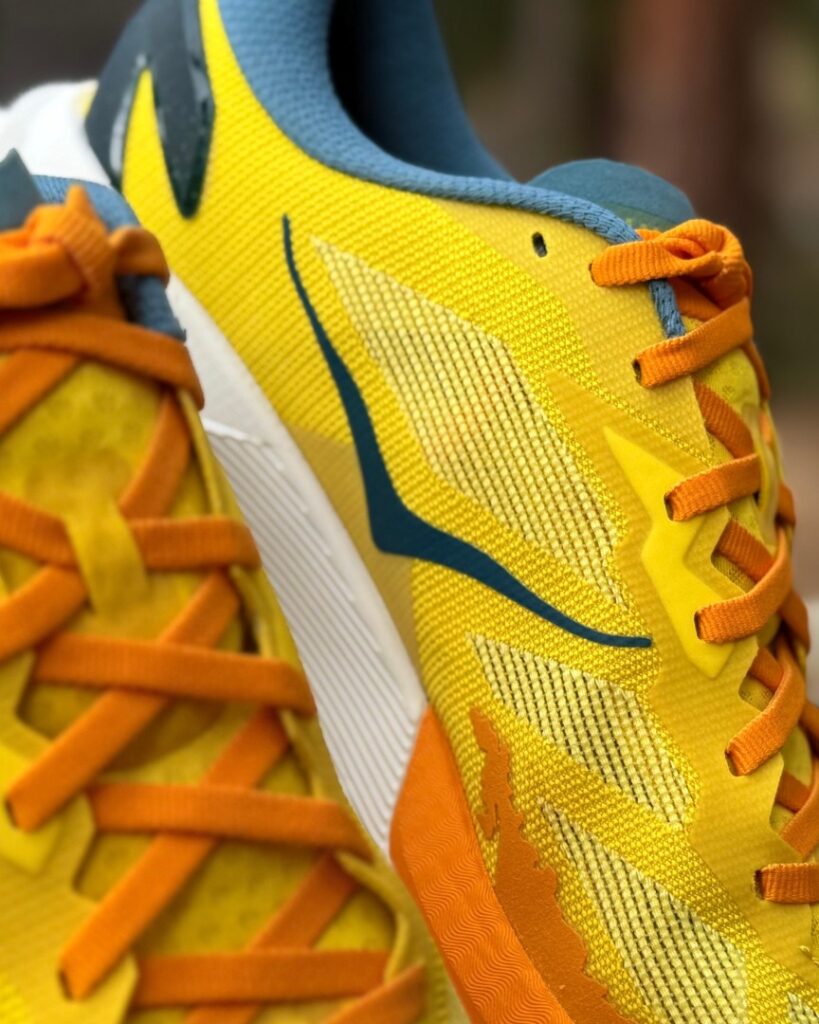
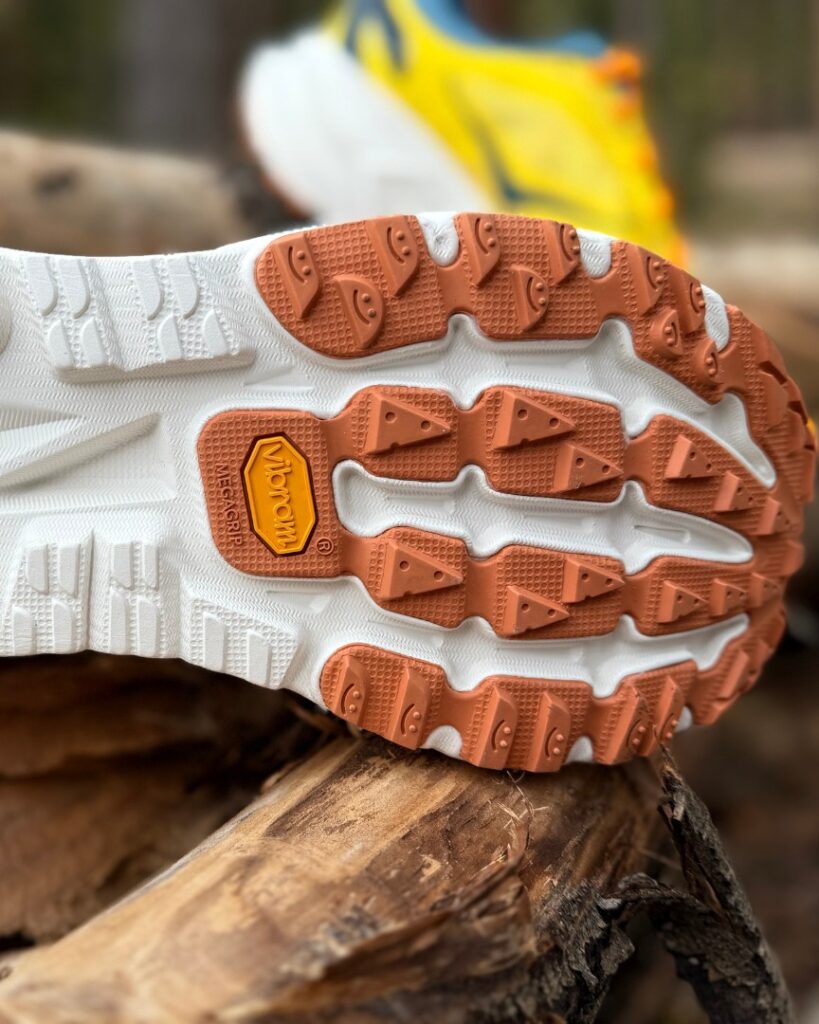
Just underfoot, the plush, luxurious feel continues with a rim and core midsole construction. A layer of peba foam mainly gave a softer step-in feel. Because it was such a thin layer, I didn’t feel any sense of responsiveness from this particular component, yet it was a really nice touch to give that Tecton X 3-like familiarity.
A supercritical EVA provided the bulk of the underfoot feel, and it was really pleasant. It wasn’t as gushy as you would expect 49mm of stack to be. It fell in that medium-soft range because of the plate embedded in the foam layers, which is honestly the best-case scenario. Like the upper, this carrier foam provided a lot of the structure needed to bring tons of comfort, complete protection, and peppy performance.
What really makes this shoe feel like a seamless experience, even though there are so many components, is the uniquely shaped carbon fiber plate design. Sure, it added some responsiveness to the outcome, but it mostly assisted in the stability department. I was honestly shocked at how well this thing gobbled up trail miles and could handle some moderately technical features quite well. I never felt that the Hoka Mafate X was an unstable ride unless I hit more technical sections and a quick clip.

I felt comfortable traversing quite a bit of terrain in this shoe because of the more dynamic stability from the plate. Don’t get me wrong — I’m not trying to peak bag in this one — but the Mafate X would fall in line with the Topo Athletic Ultraventure 4 in terms of being a much more tech-savvy runner than the company is giving it credit for.
This concoction gets some leverage from the forefoot rocker and an 8 mm drop (atypical for Hoka). Oooh baby, this was a smooth ride that really bopped on the flats and downhills. As far as protection goes, do I really need to say much? 49 millimeters is all I really need to say, yeah? Like the Merrell MTL Adapt Matryx, there was zero ground feel to speak of.
I want to give one more applause to Hoka and Vibram for their silly little outsole design that freakin’ works! I can’t tell you how many ill-willed comments I received from people who think the tacos and pizza lug design would sacrifice performance. Nah, man! These did just fine. Honestly, just as fine as a canted or chevron style lug, but they had an edge on all sides and were angled optimally. Even at 3.5 mm, I thought it was quite versatile. What more do you need?
ALLISON: The standout feature of the Mafate X is definitely the cushion. It’s next-level plush without feeling overly squishy. For longer efforts or multi-day adventures where foot fatigue becomes real, this shoe delivers the kind of comfort that keeps you moving. If you’ve struggled with underfoot pain on extended runs, the Mafate X could be a game-changer. The Vibram Megagrip outsole is a major upgrade, too. It held up incredibly well over rough terrain and didn’t show the usual wear that some other Hoka models do after a few hard efforts (looking at you, Clifton and Mach).
Plus, the lacing system felt secure and easy to dial in, which made a difference on those all-day outings. If you’re already a fan of the Skyward X but want something trail-ready with added durability and grip, the Mafate X fits right into that niche. Another highlight: the toe protection. It’s solid without being bulky, and importantly, it doesn’t intrude on the toe box. You still get that roomy forefoot feel, which is clutch when your feet swell over time. All in all, it’s a max-cushion trail shoe built for serious distance and recovery-minded runners who still want dependable performance on smoother terrain.
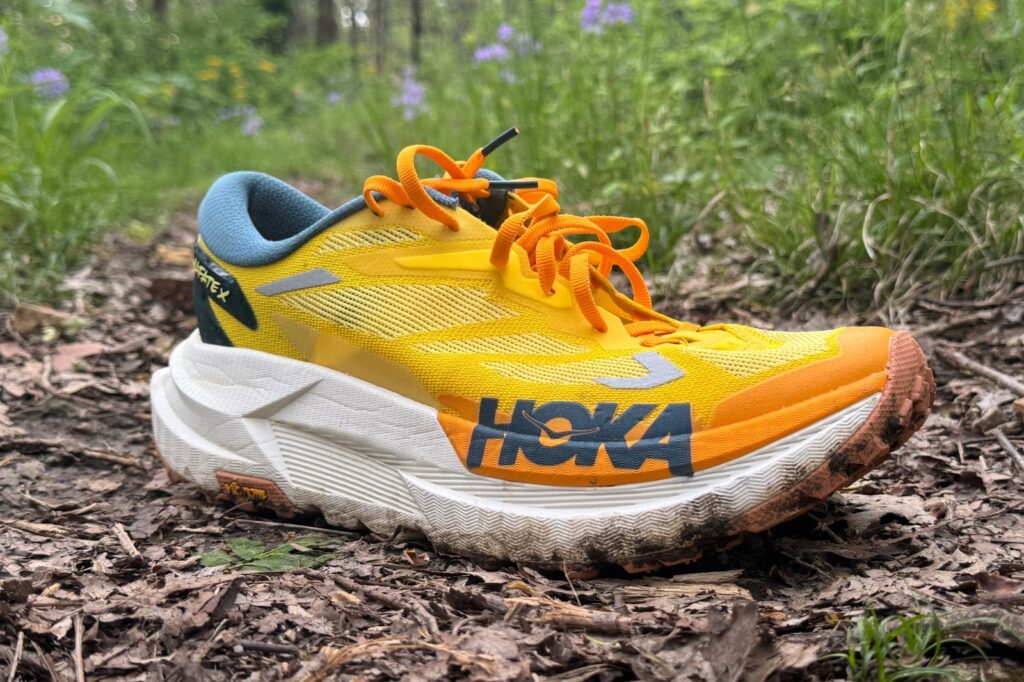
MICHAEL: My fellow reviewers have already discussed it, and I’ll discuss it again. The ride of the Mafate X is really, really smooth. Carbon plate aside, the primary enablers of this are Hoka’s use of premium materials throughout the shoe, most notably the dual-density midsole construction and proven meta rocker geometry, which provide a combination of a subtle pop, distinctive stability, and a nice roll through the stride.
Thoughtful design considerations, such as the pod-like cutouts underfoot, similar to the negative spaces we’ve seen on shoes like the new Solomon S-Lab Ultra Glide, soaked up trail chatter like a sponge. During my test mileage, even if a big, sharp rock made its way through the negative spacing and massive midsole stack, there was a carbon plate there to silence the blow. If you are an ultra-distance racer who simply does not want to feel the trail beneath you, this is probably your shoe.
Like Taylor, I enjoyed the accommodating, yet secure fit of the Mafate X from the lacing chain down through the forefoot of the shoe. The race-weight upper was a great pick as well, and added to the uniqueness and secuhowever I did experience some serious lack of security in the heel. We’ll get to that later.
Perhaps most impressively, the Mafate X is highly stable, despite its stack. Taking inspiration from the H-frame construction of its max-cushioned sibling, the Stinson, Hoka wrapped the soft, responsive PEBA foam in an EVA carrier, which kept my foot protected and cradled down the most technical descents I could find. In fact, I never once rolled my ankle or, for that matter, even felt like I was going to roll my ankle, which is usually a pretty common occurrence for me. Additionally, I noticed the added structure and stiffness of the carbon plate and massive footprint of the shoe also contribute to this regard.
Continuing the thread of higher-than-expected technical trail capability, the Mafate X’s outsole impressed as well. The Vibram Megagrip was reliable as ever and added to the shoe’s premium look and feel. Lastly, I thought the colorways we received were gorgeous.
Shop The Shoe - Men Shop The Shoe - Women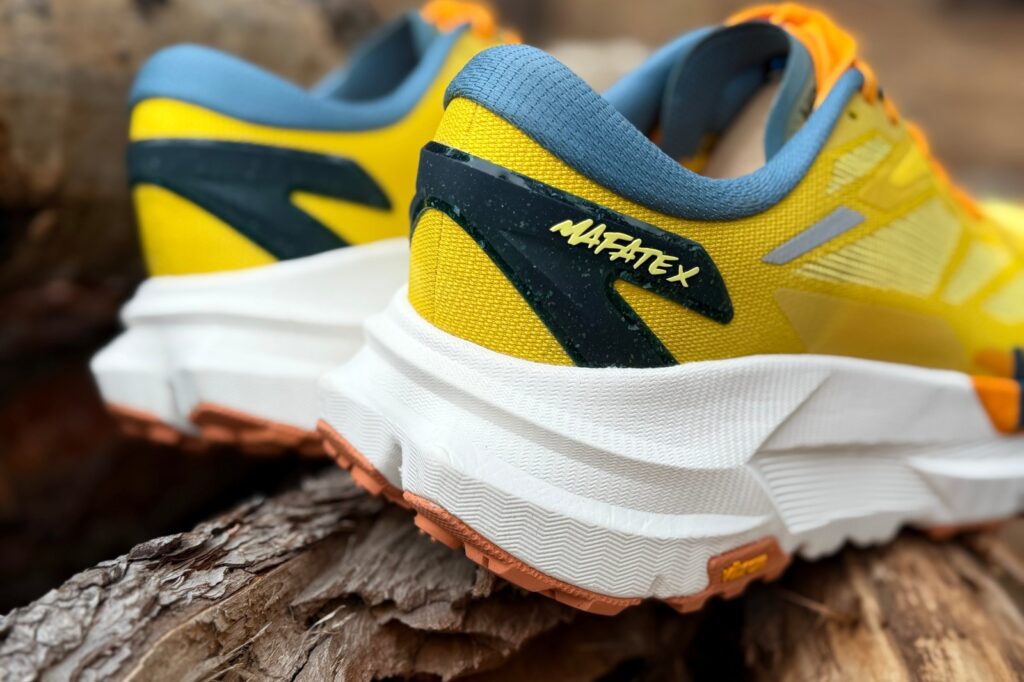
TAYLOR: Let’s deal with the elephant in the room… check that, the mammoth in the room. With all the tech, stack, this, and that comes weight. There’s no way around it. It’s a heavy shoe. Of course it is. There’s no other trail running shoe that is within 6 mm of this.
My men’s 10.5 weighed 12.7 oz. Other max stack shoes are close to the heftiest of its competitors — the Speedland GS:PDX (11.9 oz), New Balance Hierro v9 (12 oz), Merrell MTL Adapt Matrix (11.9 oz), Nike Zegama 2 (11.6 oz), Brooks Caldera 8 (11.8 oz), and The North Face Altamesa 500 (11.8 oz) — were not even within half an ounce of the Hoka Mafate X. The only shoe heavier is the Hoka Tennine; may it rest in peace.
Thankfully, as mentioned before, it’s a very smooth roller. However, over time, it became increasingly difficult to maintain a decent clip and maneuver the shoe as desired at moderate to uptempo paces. I do wish that the forefoot rocker, noteworthy foams, and plate made me forget about the weight, but that’s where we are, folks.
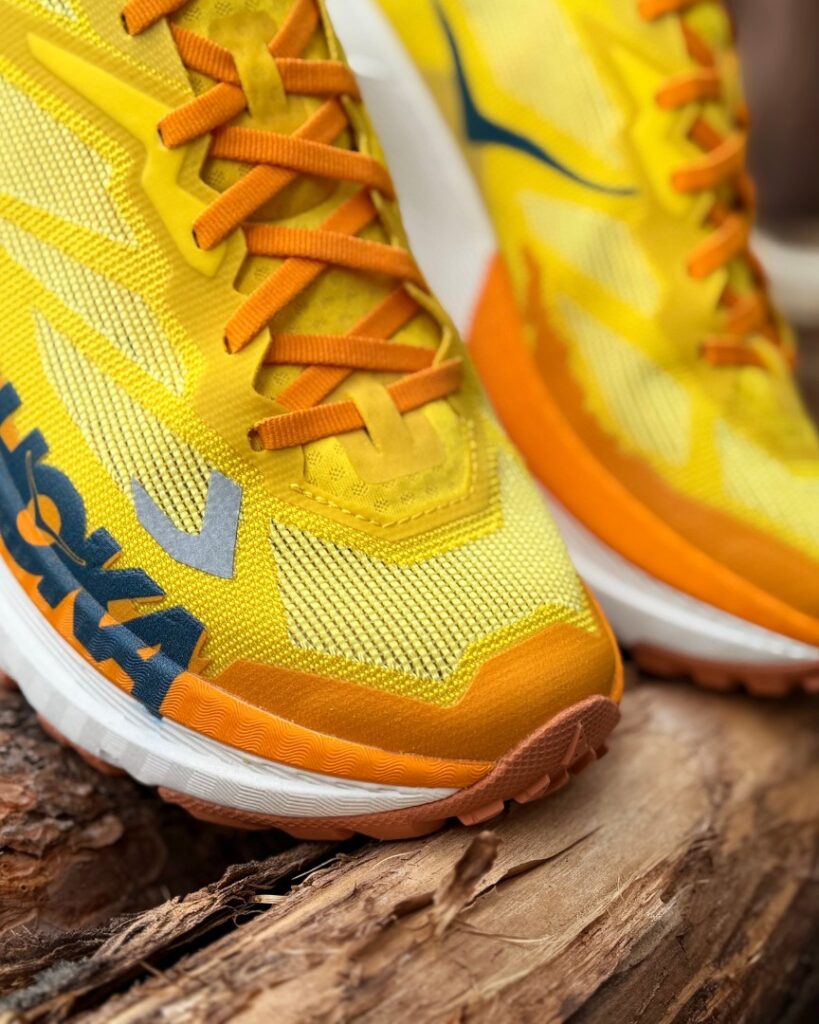
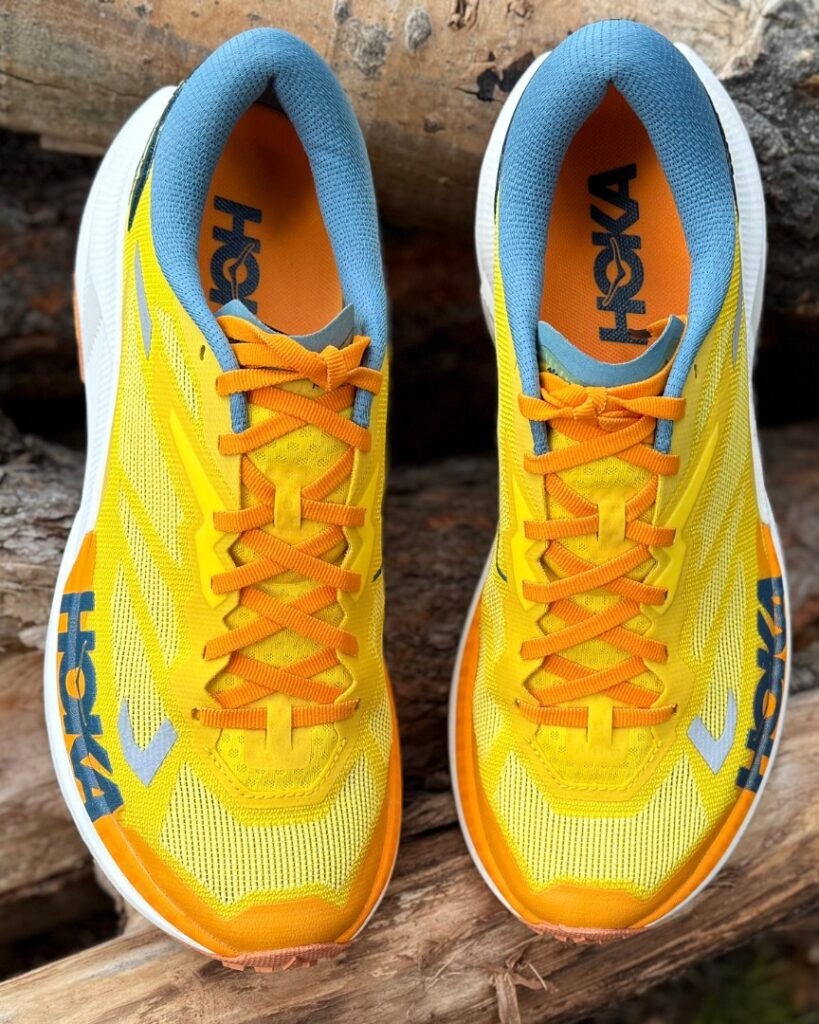
ALLISON: Just like what Taylor said above, you can’t ignore the weight — aka the “thiccness.” This shoe feels massive on foot, and for me, there was just no way to pick up any real speed, unlike the traditional Mafate. When the trail got even slightly technical, I found myself constantly adjusting to avoid rolling an ankle. The stack height gives a cushy ride, sure, but it also creates a bit of instability on uneven ground.
I totally get why this shoe seems more at home on rail-to-trail paths or smooth gravel roads. It’s just not built for anything that requires nimbleness. And then there’s the carbon plate… do we really need a carbon plate in a shoe this big? I kept wondering if it was more for recovery than performance. That’s a whole debate in itself… whether carbon even makes sense in this trail shoe or trail shoes in general.
MICHAEL: While I didn’t seem to have the stability issues Allison mentioned, several other aspects of the Mafate X left me wanting more. Starting from the bottom up, this shoe is not just heavy (and it is certainly that), but it’s really bottom-heavy. The lightweight upper, contrasted with a massive block of foam underfoot, felt especially disjointed. Whenever the trail turned uphill, instead of running in the shoe, it felt like I was carrying the shoe, let alone trying to navigate the shoe through rock gardens and tight turns in the singletrack. For me, this foible alone immediately removes the Mafate X from race day consideration, no matter how long or technical the course is.
Ever since the release of the La Sportiva Prodigio Pro, I’ve become a bit of an old, grouchy man who likes to complain about gas prices, except instead of gas prices, I like to complain about carbon plates in trail shoes. For some shoes, carbon is totally awesome and makes sense. But like Allison, I, too, have a hard time questioning the use of a plate in the Mafate X specifically. I don’t think the plate is entirely negative, as it did help give the shoe a hint of pop on the toe-off and kept things slightly more stable, but honestly, at this weight, I kind of wish Hoka would have just taken a step back, changed the name from the Mafate X to the Stinson X, and really leaned more fully into the recovery shoe aesthetic.
While the fit of the upper was largely agreeable through the forefoot, I found the heel security to be absolutely terrible. Whether I was climbing or descending, with every step on the trail, my heel would nearly lift out of the shoe, and I tried everything to stop it. Seriously, at one point, I cinched the lacing chain so tight (with the runner’s knot) the eyelets were nearly touching, cutting off circulation in my foot and everything… and I still couldn’t stop the heel lift. It was really disappointing and definitely contributed to the feeling that I was having to lug around these massive blocks of foam up the trail. I’m not even sure the heel cup is the problem here; it may just be the natural stiffness of 49mm of foam combined with a plate.
Shop The Shoe - Men Shop The Shoe - Women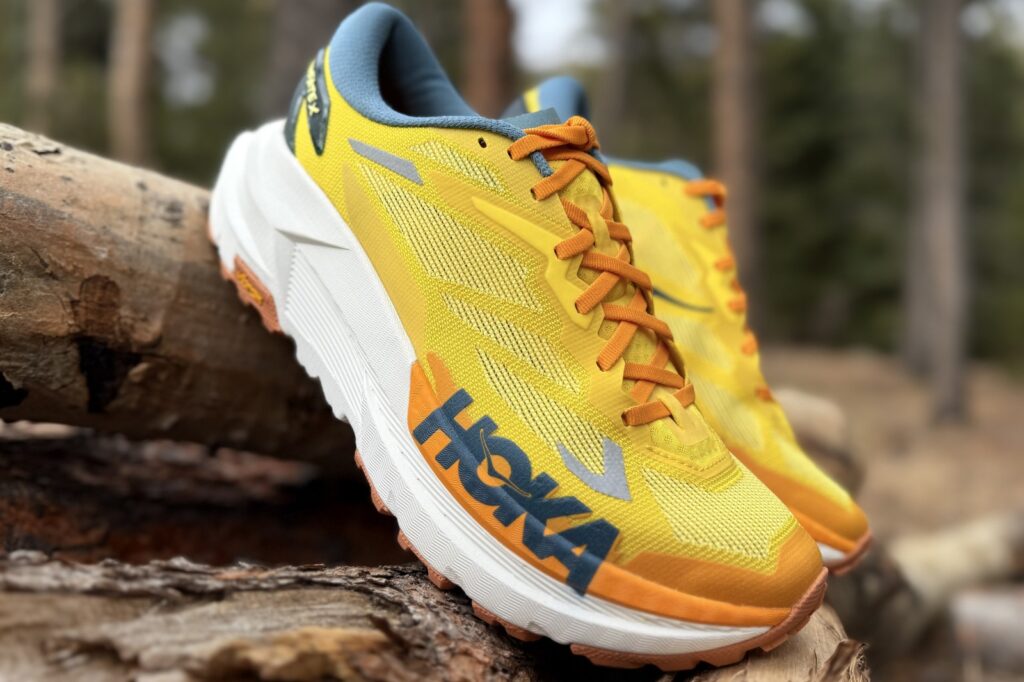
TAYLOR: This is a tricky one to score… The Hoka Mafate X has the comfort measures and tech that equate to an experience that’s absolutely premium feeling, surprisingly stable, protective, and efficient. It’s simply fun and congenial.
The hard part is that the weight is the only real negative, but it can’t be ignored.
Optimally, I think the Hoka Mafate X is the shoe many will grab for those huge 24-plus-hour adventures where pace is mostly irrelevant, knee drive is minimal, and comfort equals performance. If not for those adventures, it can easily be an enjoyable daily trail runner who wants the utmost sheltered and pleasing underfoot feel.
ALLISON: If you’re in the market for a high-cushion trail shoe built to go the distance, especially for multi-day or ultra-length efforts, the Mafate X is worth a serious look. It shines on smoother trails, gravel, and long hauls where comfort is key. If you typically train in a road shoe like the Bondi and want a trail option that delivers a similar plush feel with added grip and protection, this shoe bridges that gap perfectly.
MICHAEL: Going back to the horsemen analogy, I think it’s safe to say Hoka dealt with 1.5 of the 3 horsemen (or are there four?) fairly well. I found the Mafate X to be impressively stable, and I do think the plate helped a bit with keeping the shoe from feeling as sluggish as it could have been. With its premium materials and plush cushioning, the wildly comfortable ride underfoot (and thus, the main appeal) of the Mafate X is absolutely there, but weight really brought this one back down to earth for me.
This brings me to my final conclusion… if weight takes this shoe out of contention for race day or technical, mountainous long runs, then who is this for? Or maybe I should ask more specifically, who is going to want to spend $225 for an ultra-premium smooth-trail long run/recovery shoe? I’m not at all trying to say that no one should buy the Mafate X, but I do want to highlight just how niche this shoe is. At the end of the day, though, unlike the salmon hats, comfort never goes out of style. The Mafate X has it in spades.
You can pick up the Hoka Mafate X for $225 from Running Warehouse (featuring free shipping and 90-day returns) by using the buttons below.
Shop The Shoe - Men Shop The Shoe - WomenHave something to say? Leave a Comment

Taylor Bodin is a trail and ultra runner living in Estes Park, Colo., with his wife and daughters. As the head of the Dirt Division at Believe in the Run, trail running is pretty much the only hobby he can manage right now and loves it. Every so often, he will pop off a race or FKT attempt because competition is pure and the original motivator for him getting into running anyway.
More from Taylor
An engineer living with his wife and cat in Birmingham, Ala., Michael loves chill morning runs in the neighborhood, but especially enjoys soaking up long miles of technical southeast singletrack. Occasionally, he’ll get a racing itch and actually string together some “organized” training for a trail race or FKT. In his free time, Michael enjoys books, backpacking, and hanging out with friends.
More from Michael
Born and raised in Atlanta, Georgia, Allison is a die-hard sports enthusiast and long distance runner. As co-leader of Trail Sisters and FKT manager, she’s dedicated to fostering community and empowerment in the outdoors. Fun fact: she met her husband on Strava, proving that it does go down in the DMs.
More from Allison Read Article
Read Article

